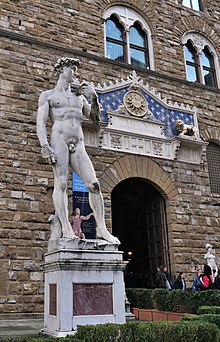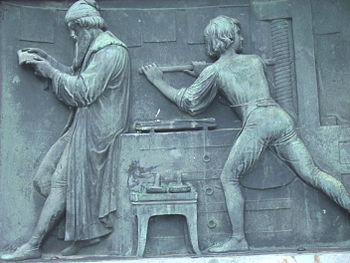Modern history
According to a common periodization scheme, the modern era is the third of the major historical epochs after antiquity and the Middle Ages and extends to the present. In historiography, the beginning of the modern era is considered to be the turn of the 15th and 16th centuries, which is perceived as a turning point in several respects, with a certain temporal range - and especially from a European perspective.
Examples of epochal turning points are the Ottoman conquest of Constantinople in 1453, the discovery of America in 1492 and the Reformation initiated by Martin Luther in 1517. From the point of view of cultural history, the Renaissance, humanism and the development of printing in Europe with movable type stamps can also be regarded as turning points. In the sense of a unification of the different levels of observation, the round year 1500 has become customary by historians for the dating of the beginning of the modern era.
Epochs within modern history that follow the Age of Discoveries, early colonialism, and the Reformation and Counter-Reformation are, in Europe, the era of the Thirty Years' War and the Age of Enlightenment; on a global scale, the spread of the Industrial Revolution, the "long" 19th century with the era of imperialism, and the "short" 20th century (with the two world wars, the Holocaust, and the nuclear standoff), which has passed into contemporary history.
The special characteristics of the modern era in contrast to earlier epochs of human history include reduced birth rates with extended life expectancy, an accelerated change in economic and social conditions as well as the globalization of transport connections, economic contexts and communication possibilities. Scientific knowledge, revolutionary upheavals, capitalist economic structures and the democratic striving for freedom are significant as accelerating factors of modern change. The modern optimism of progress, which has dominated for a long time, is subjected to critical reflection in view of humanitarian setbacks and unsolved human problems, such as those associated with the climate crisis.

Artistic beginnings of the modern era: Michelangelo's David as a marble copy at the entrance to the Palazzo Vecchio in Florence
Term History
The idea of a new era or modern age as a historical epoch at the transition from the 15th to the 16th century goes back to the Renaissance humanists, who placed a middle age between their present and the surviving testimonies of antiquity, which they sought to follow up as exemplary. Beyond this middle age, therefore, a new era began for them with their rediscoveries.
A division of human history into antiquity, the Middle Ages and modern times was first presented in 1702 by Christoph Cellarius, a grammar school director and historian from Halle, in the Latin title of his three-volume textbook: Historia universalis, in antiquam et mediaevi ac novam divisa. However, a corresponding scheme had already been used by Justus Lipsius, who in 1601 divided Roman history into historia romana vetus, historia romana media, historia romana nova.
Temporal extension and subdivision
→ Main article: Periodization
Where modern times serve to structure history despite the Eurocentric starting perspective, there is relative consensus among historians to date the beginning around 1500. The transition from the fifteenth to the sixteenth century was marked by a series of drastic developments, some of which overlapped, including the Renaissance, the printing press, the Reformation, the important voyages of discovery, early capitalism and the early modern state. Included in this context are important individual events, which in turn have sometimes been considered the beginning of the modern era: the conquest of Constantinople in 1453, the discovery of America in 1492, or Luther's 95 Theses in 1517.
The end of the modern era coincides with the respective present, unless - in deviation from the classical three-part division - recent history and contemporary history are kept separately. Further elements of a subdivision of the modern era are the early modern era in the period between 1500 and 1800 as well as the long 19th and the short 20th century.
As an alternative to a periodization of the modern era with the epochal boundary at 1500, the idea of a saddle period on a global scale from 1750 to 1850 is discussed, in which far-reaching impulses emanated from the Atlantic Revolutions and the Industrial Revolution. It has also been suggested that the entire epoch between the High Middle Ages and the end of the 18th century should be referred to as "Old Europe" and that the beginning of the modern era should only be placed thereafter.

Relief printer at the Gutenberg monument, Mainz
Questions and Answers
Q: What is modern history?
A: Modern history is the history of the world beginning after the Middle Ages, generally referring to the period since the advent of the Age of Reason and Enlightenment in the 17th and 18th centuries and the beginning of Industrial Revolution.
Q: When did Early Modern Times take place?
A: The Early Modern Times took place from the end of 15th century to the Industrial Revolution at the end of 18th century, circa 1450/92 to 1750/92.
Q: What is modernity based on?
A: Modernity is based on Modernism, which explores changes in society due to industrialization.
Q: How does postmodernity relate to modernity?
A: Postmodernity and Postindustrialism are theories that apply art movement term postmodernism to social and cultural history, or refer to rise of service sector during late 20th century when industry was no longer predominant; prefix "post-" implies reaction to modernity.
Q: What advances have been made during this time period?
A: During this time period there have been many advances in science, politics, warfare, technology, and globalization.
Q: How did European powers expand their influence during this time period? A: During this time period European powers began expanding their political, economic, and cultural influences to rest of world.
Search within the encyclopedia